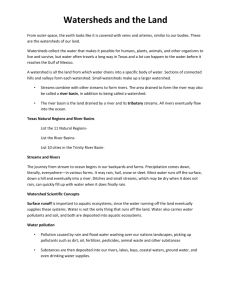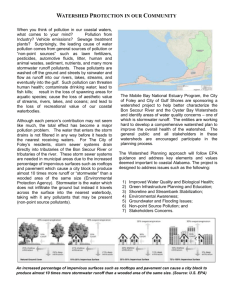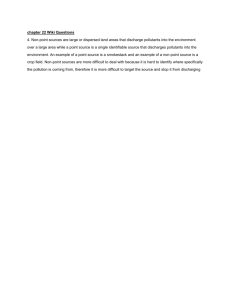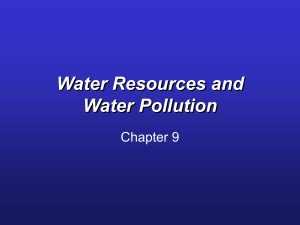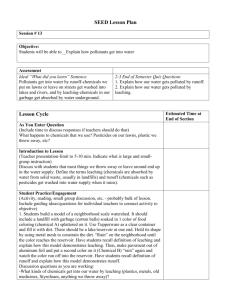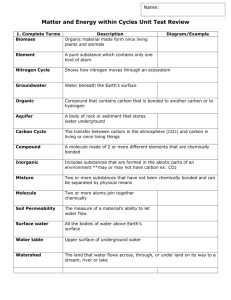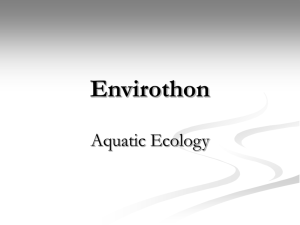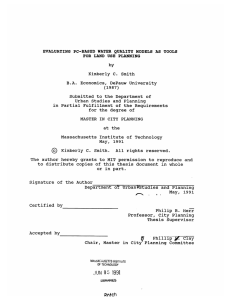Unit 9 : Rivers, Streams, Groundwater
advertisement
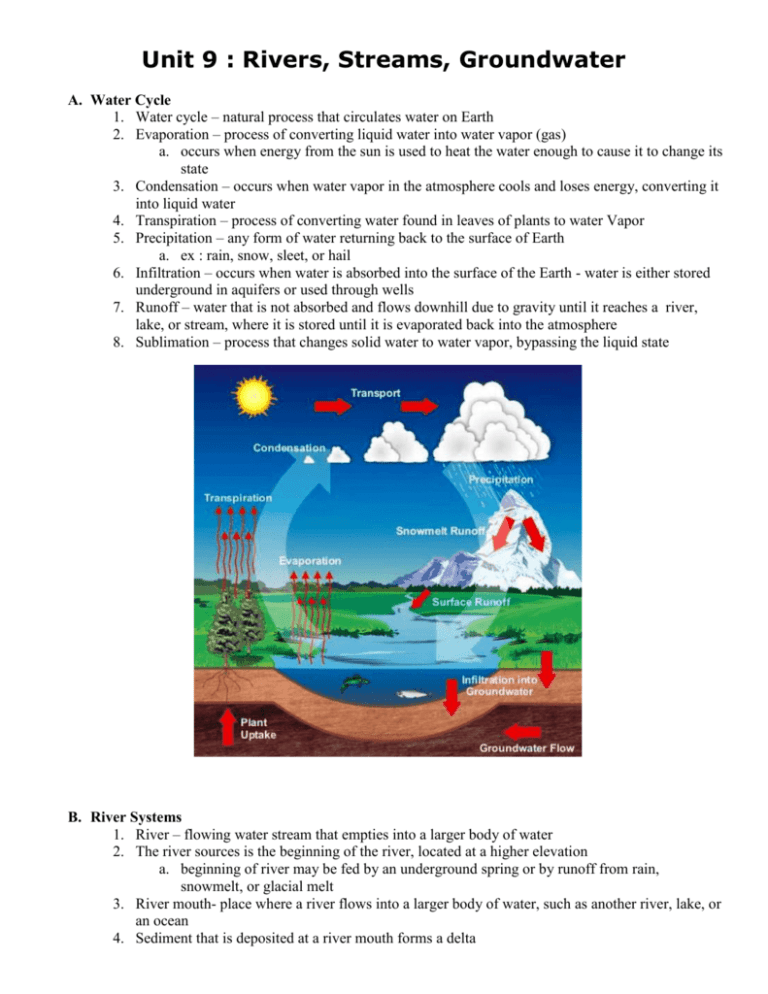
Unit 9 : Rivers, Streams, Groundwater A. Water Cycle 1. Water cycle – natural process that circulates water on Earth 2. Evaporation – process of converting liquid water into water vapor (gas) a. occurs when energy from the sun is used to heat the water enough to cause it to change its state 3. Condensation – occurs when water vapor in the atmosphere cools and loses energy, converting it into liquid water 4. Transpiration – process of converting water found in leaves of plants to water Vapor 5. Precipitation – any form of water returning back to the surface of Earth a. ex : rain, snow, sleet, or hail 6. Infiltration – occurs when water is absorbed into the surface of the Earth - water is either stored underground in aquifers or used through wells 7. Runoff – water that is not absorbed and flows downhill due to gravity until it reaches a river, lake, or stream, where it is stored until it is evaporated back into the atmosphere 8. Sublimation – process that changes solid water to water vapor, bypassing the liquid state B. River Systems 1. River – flowing water stream that empties into a larger body of water 2. The river sources is the beginning of the river, located at a higher elevation a. beginning of river may be fed by an underground spring or by runoff from rain, snowmelt, or glacial melt 3. River mouth- place where a river flows into a larger body of water, such as another river, lake, or an ocean 4. Sediment that is deposited at a river mouth forms a delta 5. Direction of river a. upstream – direction of, or nearer to the source of a river b. downstream – direction of, or nearer to the mouth of a river 6. Wetlands – low-lying areas saturated with water for long enough periods to support vegetation adapted to wet conditions a. wetlands help maintain river quality by filtering out pollutants and sediments, and regulating nutrient flow 7. Floodplain – relatively flat land stretching from either side of a river, which may flood during heavy rain or snowmelt a. soil in floodplains is often rich in nutrients and ideal for growing food 8. Tributary – smaller stream or river that joins a larger stream or main river 9. Watershed – tract of land drained by a river and its tributaries 10. Watershed boundary – (aka drainage divide) marks the outermost limited of a watershed 11. Meandering river – winds back and forth, rather than following a straight course 12. Three phases of rivers : young, mature, old C. Floods 1. Groundwater levels increase due to increased rainfall 2. The water table (area where groundwater is collected) becomes saturated, not being able to absorb additional water 3. As a result, the water table rises causing water on the surface to flood D. Water Uses 1. Wells – a hole dug in the earth used to pump water a. benefit : water is available for consumption b. danger : excessive pumping can lead to groundwater depletion 2. Dams – barriers built to restrict water flow a. benefit : used to store water, provide water for irrigation, and generating hydroelectric power b. danger : trap sediments from flowing water sources, reducing water volume before the dam and causing further erosion downstream c. danger : dam removal : land downstream is flood, chemical and pollutants are released, and stream banks are destroyed 3. Agriculture – use of water for crops a. benefits : crops grow b. dangers : fertilizers and pesticides can effect streams, lakes, and river which leads to human and animal consumption, and lowered water quality E. Aquifer Depletion 1. Aquifer – permeable underground layer through which groundwater flows easily 2. Salt a. Salt pollution is a threat to the water available in an aquifer b. Freshwater becomes contaminated with salt water when wells are over-pumped 3. Subsidence a. Water pressure helps to keep the land above the aquifer up b. As a result of excessive withdrawal of water, the land above the aquifer sinks F. Watersheds 1. Watershed – area of land where all of the water drains and goes into the same place 2. Storm-water runoff threatens watershed quality 3. As water runs over and through the watershed it picks up and carries contaminants and soil a. leaked motor oil, pesticides, fertilizers, detergents, and sediments 4. These pollutants wash directly into waterways carried by runoff from rain and infiltrate ground water 5. Pollutants then concentrate in streams and rivers and can be carried downstream into the ocean 6. These pollutants then effect the amount of oxygen and food sources in the waters which negatively impacts aquatic animals 7. Pollutants affect recreational waters by making them unusable for swimming, fishing, and drinking G. Water Treatment 1. After wastewater has been treated, it is returned back to rivers and streams to be re-used as drinking water 2. Wastewater treatment plants improve the quality of water that is discharged and returned to water sources 3. Unfortunately, we are creating more wastewater faster than we can clean it causing a rise in the cost to treat waste water H. Humans need Water 1. As the population of Earth increases, water availability decreases 2. In undeveloped countries, water is expensive to transport and difficult to purify causing a water shortage I. Eutrophication 1. Eutrophication – too many nutrients runoff into a small body of water causing algal bloom 2. Wetlands and estuaries can be destroyed when large amounts of algal blooms lower the amount of oxygen in the water, thus causing fish and other animals in the water to die a. wetland – land area that is covered with water for a large part of the year ( ex : bogs, marshes, swamps) b. estuary – the area where lower end of a freshwater river or stream enters the ocean J. Pollution 1. Pollution occurs when hazardous material comes in contact and dissolves in Water 2. Point source pollution – comes from a specific source(s) which can be identified a. ex : wastewater treatment plant or industry 3. Non-point source pollution – source of pollution cannot be directly identified a. Ex : runoff, pet waste, construction sites b. Construction can cause significant increase in sediment in nearby waterways c. Removal of vegetation exposes soil and causes more erosion d. Suspended solids (turbidity) from erosion prevents sunlight from reaching aquatic plants e. without light, photosynthesis cannot take place which reduces the amount of available oxygen f. Increased turbidity can also make it hard for fish to see their prey, can lead to clogged fish gills, and can interfere with filter-feeding organisms that live in water g. As solid matter settles, it may cover and arm plants and animals, and spawning beds h. Stormwater runoff can pick up sediment and pollutants and deposit them into water systems that are used consumption and recreation i. Arsenic (causes cancer and diabetes) can be introduced naturally through rocks or unnaturally by industry K. Human Activity and Shorelines 1. Human activity accelerate the natural shoreline erosion process 2. Clearing natural vegetation a. Often done by landowners b. Destroys the roots of plants that provide significant shoreline stabilization 3. Construction or development a. When done uphill from a shoreline, it can result in increased stormwater runoff b. Results in increased sediment loads in the water 4. Structures a. Pavement, buildings, roofs, drainage ditches all increase the amount of speed and energy of stormwater b. This results in more runoff being routed to streams and lakes c. Increases shoreline erosion 5. Agriculture a. Increase levels of nutrients in streams and lakes (eutrophication) b. Effects are greatest in the spring when snow is melting, the soil is saturated, and water runoff is highest 6. Shoreline projects a. Erecting walls can reduce habitats b. Redirects waves away from the area in which the wall was installed c. Changes the natural “drift” of loose materials L. Conservation Measures 1. Development of alternative sources of supply 2. Reduce the use of water while showering, cleaning, and brushing teeth 3. Monitor water sources 4. Efficient planning for land use projects 5. Public awareness
